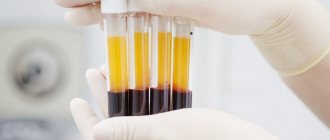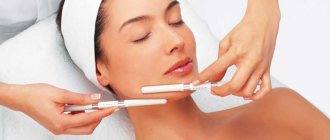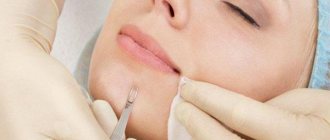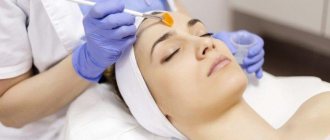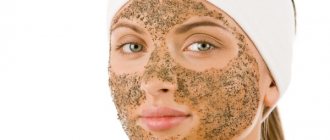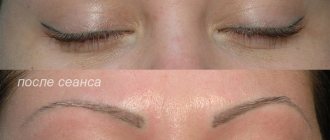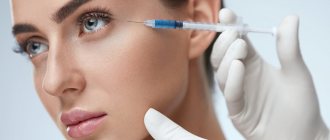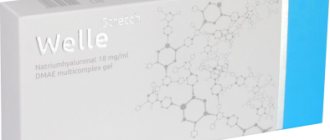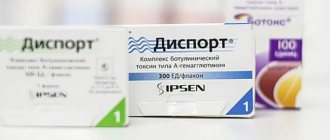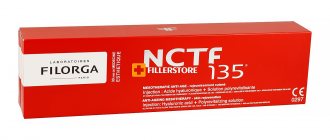The delicate skin of the face and neck most clearly reveals a person’s age, because it is here that it is characterized by its minimum thickness. Moreover, it is often even difficult to understand what exactly reflects the traces of past years, experiences and joys. A slight decrease in skin tone even before the appearance of facial wrinkles, pigment spots, not to mention spreading crow's feet, wrinkles on the forehead, between the eyebrows and ring folds on the neck will instantly reveal the age of both women and men. Today there are many cosmetic procedures that allow, if not to slow down the passage of time, then at least to reduce its reflection on the face and neck. One of the safest methods of injection rejuvenation is plasma lifting. Therefore, it is worth considering in detail when it should be performed, and when the procedure is contraindicated, what features it has and what results it gives.
What is plasma lifting
Plasmolifting or PRP therapy is not only a cosmetic, but also a medical procedure that involves the injection into the skin of blood plasma obtained from the patient and separated from blood cells, which is also called autoplasma. The method has many uses, one of which is increasing skin elasticity and reducing wrinkles. This has made it in demand in cosmetology, in particular for rejuvenating the face and neck, both in women and men.
Plasmolifting is also used to eliminate stretch marks, combat hair loss and for many other purposes.
Plasma itself is the liquid component of blood. It contains special formed elements of blood - platelets. These small blood platelets, which do not have a nucleus, are synthesized in red bone marrow cells and help to activate the skin repair process. They, in fact, are fragments of megakaryocytes, which are the precursors of all blood cells. And on their surface are concentrated the so-called growth factors, the composition of which ensures an influence on all stages of regeneration simultaneously.
In addition to growth factors, plasma contains micro- and macroelements, vitamins and amino acids.
Platelets contain growth factors such as:
- insulin-like (IGF) – promotes the differentiation of stem cells, enhances the production of its own collagen and accelerates metabolic processes in bone tissue;
- platelet-derived (PDGF) – activates cell reproduction (proliferation) and the formation of new blood vessels;
- transforming (TGF-β) – triggers cell differentiation and activates bone repair processes;
- epidermal (EGF) – activates the division of fibroblasts and the formation of fibronectin, which is involved in the suppression of inflammation;
- fibroblastic (FGF) – increases the intensity of the formation of new blood vessels and has a positive effect on the rate of bone recovery;
- platelet-derived endothelial cell factor (PDEGF) – helps maintain the integrity of capillaries and has a positive effect on the functioning of endothelial cells;
- vascular endothelium (VEGF) – promotes the strengthening and growth of blood vessels in the thickness of the skin, due to which there is an improvement in blood supply to tissues, which leads to increased metabolism;
- placental (PLGF) – increases the positive effect of vascular endothelial growth factor and improves the permeability of blood vessel walls.
The presence of these growth factors and their properties explains the wide application of plasma lifting in the treatment of various diseases of bones, joints, and genital organs.
When plasma is injected into the thickness of the skin, concentrated platelets, together with growth factors, lead to increased activity and the formation of new fibroblasts. They are a special kind of cells that synthesize collagen fibers, hyaluronic acid and elastin. As a result, the formation of young connective tissue and the growth of small blood vessels begins. This helps to improve the course of metabolic processes, improve the quality of microcirculation, tissue respiration and stimulate local immunity.
Therefore, with the help of the procedure it is possible to maintain elasticity and ensure smoothness of the skin. As a result of improved metabolic processes and increased blood circulation, the skin in the affected area acquires a healthy, rich color. And strengthening local immunity in combination with improving microcirculation contributes to the rapid elimination of inflammatory processes, characteristic, for example, of acne.
Since all this is achieved by stimulating the body’s internal resources and is not accompanied by the introduction of foreign substances, the procedure is highly safe and cannot lead to complications if the rules of its implementation and skin care are followed. Otherwise, the injection sites may become infected.
The technique for obtaining and using blood plasma for medicinal purposes was developed in 1975 in the USA, and over the subsequent years it has been constantly improved. The result of the work of many scientists was PRP therapy in the form in which it is used now.
History of the use of platelet-rich plasma –
Platelet-rich plasma has been used in medicine since 1975.
Initially, it was used only for gluing the cornea of the eye, seamless fusion of nerves (24stoma.ru). Animal studies have shown that platelets and fibrin in elevated concentrations accelerate the processes of cell migration and collagen synthesis, as well as fibroplasia and angiogenesis, which leads to faster tissue healing. However, the widespread use of platelet-rich plasma in surgery began only in 1986, when some experience with its use was accumulated and the first studies were published. In 1997, an article was published that discussed the effectiveness of plasma in regenerating facial bones. After this, plasma began to be actively used in dentistry during implantation operations, operations to increase bone levels during periodontitis, for the treatment of wounds and soft tissue injuries.
Today, plasma is used in orthopedic surgery, traumatology, cosmetic and plastic surgery, gastrointestinal surgery, cardiac bypass surgery, spine surgery, etc. In the last decade, platelet-rich plasma has begun to attract the attention of dermatologists and cosmetologists for aesthetic purposes for skin rejuvenation.
Plasmolifting: video
Effect of PRP therapy
Growth factors contained in the blood plasma, especially epidermal growth, contribute to:
- proliferation (division) of cells, which provides a rejuvenating effect;
- formation of collagen and elastin fibers;
- activation of the production of your own hyaluronic acid;
- eliminating dead skin cells, feelings of dryness, tightness of the skin and increasing the skin’s ability to retain moisture;
- eliminating skin irritation, protecting it from damage and the negative effects of ultraviolet rays and low temperatures;
- reducing the risk of the formation of new pigment spots and reducing the color intensity of existing ones;
- accelerating growth and improving the functioning of blood vessels.
Thus, plasma lifting not only promotes skin cell renewal, but also has a beneficial effect on the quality of its blood supply. As a result, metabolic processes accelerate, the skin is renewed, and its appearance improves.
One of the main advantages of plasma lifting is the absence of the risk of side effects if the procedure technology and antiseptic rules are followed. This is explained by the fact that nothing foreign is introduced into the body, because the plasma used for injections is taken from the patient’s own blood. Therefore, when performing plasma lifting of the face and neck, you should not be afraid of the development of allergic reactions or other negative consequences.
In cosmetology, plasma lifting began to be used only recently. Previously, it was considered an exclusively medical procedure, which was used in the treatment of gynecological, dental, orthopedic, urological diseases, as well as the rehabilitation of patients after maxillofacial injuries and operations.
The procedure provides:
- improvement of complexion and skin condition in general;
- reducing the depth of wrinkles up to their complete smoothing in the case of facial wrinkles;
- elimination or reduction of the severity of pigment spots of various types;
- active nutrition and moisturizing of the skin;
- increasing skin tone, which improves the oval of the face, i.e. a lifting effect;
- elimination of acne and signs of rosacea;
- reducing the severity of scars, including post-acne.
The effect after the procedure does not appear immediately. The first positive changes can be noticed on average 2-3 days after it is carried out, but the final result is assessed no earlier than at the end of the second week.
As a rule, to obtain a lasting result, you need to undergo a course of procedures consisting of 2-6 sessions. Their number depends on the initial condition of the skin and the severity of the existing problem. Procedures are carried out at intervals of several weeks, although in mild cases it can increase to 2-3 months. After completing the course of plasma lifting of the face and neck, the achieved result lasts for up to a year.
Indications
- Prevention of aging . In childhood, tissues are renewed quickly, but over time this process slows down. Plasma therapy allows you to prolong youth and prevent the appearance of such unpleasant phenomena as wrinkles, excessive dryness, and lack of elasticity.
- Age-related changes . Wrinkles, enlarged pores, sagging, pigmentation, dull complexion - all these problems can be eliminated with the help of microinjections of your own plasma. Under the influence of platelet-derived growth factors, skin regeneration processes are launched and signs of aging are erased. Of course, it will not be possible to turn back time, but plasma therapy can eliminate unpleasant symptoms and restore youthful freshness and beauty to the face.
- Scars and scars . Plasmolifting stimulates skin renewal and improves blood circulation in the treated area - what is needed to get rid of scars and scars. The defects gradually resolve, becoming almost invisible.
- Acne . The procedure is recommended in the stage of remission of the disease, when there are no more than a couple of pustules on the skin. The effect regulates the activity of the sebaceous glands, which, in turn, helps prevent the occurrence of new rashes.
- Post-acne . Acne causes a lot of trouble for its owners even after the acne disappears. Where there used to be inflamed acne, scars and stagnant spots remain. PRP therapy effectively combats them. Skin cells are actively renewed, spots disappear, and the relief is evened out.
- Rehabilitation after traumatic cosmetic procedures . Some procedures involve damage to the skin. Such measures have a mobilizing effect on the epidermal cells, stimulating the production of compounds for the speedy restoration and renewal of the skin. The effect can be good, but rehabilitation sometimes takes a couple of weeks, or even more. To help the skin recover, PRP therapy is used. Thanks to her, the rehabilitation process is accelerated.
- Hair loss, poor condition . Plasmolifting has also proven itself in hair restoration. The procedure improves blood circulation in the scalp, and subsequently the nutrition of the hair follicles improves. The growth factors contained in plasma rejuvenate the skin and improve its condition.
Plasma therapy can be used in other cases - in addition to other procedures or independently. At your appointment, the cosmetologist will assess how appropriate it is to use the therapy in your case, and what effect can be achieved this way.
When should you do plasma lifting?
Due to its safety and effectiveness, plasma lifting is a fairly universal procedure. Therefore, it can be recommended in a wide variety of situations, including:
- the appearance of signs of decreased firmness and elasticity of the skin;
- age-related changes in the skin, especially fine wrinkles and medium depth;
- dryness, flaking of the skin;
- pigment spots of different nature, in particular those caused by photoaging;
- acne (acne) and post-acne in any manifestations;
- the formation of scars on the skin of the face and neck as a result of injury, certain diseases, or surgical interventions;
- skin depletion as a result of aggressive cosmetic procedures, including deep peelings and laser resurfacing;
- recovery after plastic surgery.
When treating acne, post-acne and large scars, plasma lifting can only act as a component of a comprehensive program, since these dermatological problems are persistent and difficult to correct.
Plasmolifting of the face and neck can be performed after 25 years, except in cases where it is necessary for the treatment of acne. But with pronounced age-related changes, for example, with a significant deterioration of the oval of the face due to ptosis of soft tissues, PRP therapy will be ineffective, especially when used in isolation. Therefore, older patients are offered either more radical methods of rejuvenation, or combinations of plasma lifting with other cosmetic procedures. In the latter case, their nature, combination and frequency are determined individually depending on the initial condition of the skin, type of aging, the presence of chronic diseases and a number of other features.
Combination with other procedures
Plasmolifting is most often carried out in combination with other cosmetic procedures, in particular laser resurfacing, biorevitalization, injection of fillers, thread lifting and some others.
Fillers and plasma lifting
The most often proposed is the introduction of fillers based on hyaluronic acid with plasma lifting of the face and neck. Initially, it is recommended to undergo a course of PRP therapy, consisting of 2-4 procedures performed once a week, and a week after its completion, injections of hyaluronic acid-based filler are performed.
Fillers fill all the unevenness of the skin, significantly improving its relief and eliminating even pronounced creases and wrinkles, and blood plasma saturated with platelets and fibrin ensures rapid tissue restoration and improvement of the skin condition in general. Therefore, this combination is indicated for patients with aging skin and pronounced age-related changes. It allows you to get an instant effect in the form of:
- lifting effect;
- reducing the depth of wrinkles and folds, including nasolabial, ring folds of the neck and others;
- improving the structure and color of the skin, which ensures a pronounced effect of rejuvenation and radiance of the skin.
The combination of plasma lifting with the introduction of fillers allows you to increase the duration of the latter by 3-6 months.
Laser treatments and PRP therapy
Combining PRP therapy with laser facial procedures, in particular fractional laser resurfacing, is also very effective. This combination is indicated to improve the overall appearance of the skin in the absence of pronounced age-related changes. Fractional laser exposure involves the evaporation of intracellular and extracellular fluid under the influence of a focused laser beam. As a result, microdamages of the skin are formed in the form of a grid of dots without compromising the integrity of its outer layer. All points are located at equal distances from each other. This activates the process of synthesis of elastin and collagen fibers, the production of hyaluronic acid and improves the condition of the skin in general. At the same time, the introduction of plasma will ensure faster restoration of microdamages and a reduction in the recovery period.
As a result, this combination of cosmetic procedures improves facial contour, skin texture, tone and overall condition. At the same time, it allows you to reduce the number of laser therapy sessions and prolong the achieved effect. But it does not allow you to fight pronounced wrinkles, but only helps to slightly smooth them out.
Botulinum toxin A and plasma lifting
The introduction of botulinum toxin A (Botox, Xeomin, Dysport) together with plasma injections helps improve the condition of the skin and smooth out facial wrinkles. But this combination requires special care when performing injections, since platelet-rich plasma helps improve blood circulation and faster tissue regeneration, which shortens the period of action of botulinum toxin. Therefore, plasma lifting is initially carried out and a week later, botulinum toxin is administered, or Botox or another drug is first injected and only 3 weeks after that PRP therapy is carried out.
PRP therapy and biorevitalization
This combination of cosmetic procedures allows you to get the best results in the fight against photoaging of the face and neck, as well as significantly prolong the effect of biorevitalization. Plasmolifting and intradermal injections of hyaluronic acid are performed alternately at intervals of a week. The general course consists of 4 plasma injection procedures and 4 biorevitalization sessions. But it is also permissible to carry out 2 plasma lifting procedures in a row with an interval of a week, and then 2 biorevitalization procedures.
Plasmolifting and intralipotherapy
This combination is used to eliminate a double chin. Initially, 2 sessions of PRP therapy are carried out with an interval of 7 days, after which a lipolytic is injected into the subcutaneous fat tissue, which will break down fat cells, and then a month later, plasma lifting is repeated 1-3 times. As a result of this combination, the volume of the double chin will decrease under the influence of lipolytic, and platelet-rich plasma will prevent the skin from losing tone and sagging.
PRP therapy and thread lifting
Carrying out plasma lifting 10-14 days before the installation of threads ensures a reduction in the recovery period and an additional effect of skin rejuvenation. As a result, after thread lifting, signs of inflammation and swelling of the tissues of the face and neck are eliminated more quickly.
Contraindications
Plasmolifting of the face and neck is a safe procedure. However, in a number of situations it is undesirable. But there are not many absolute contraindications that completely exclude the possibility of carrying out the procedure. In most cases, it is enough to postpone plasma lifting of the face and neck until the condition improves.
So, the procedure is not carried out when:
- pregnancy and during breastfeeding;
- bleeding disorders or long-term use of medications that have blood thinning properties;
- oncological diseases;
- decompensated diabetes mellitus;
- serious autoimmune diseases;
- acute infectious diseases;
- exacerbations of chronic diseases;
- inflammatory processes in the skin of the face and neck in the area of influence.
Preparation for the procedure
Plasmolifting, unlike other cosmetic procedures, requires certain preparation. It cannot be called complicated, but still, the recommendations of specialists should not be neglected in order to get the maximum result and avoid undesirable consequences.
So, initially you should choose a cosmetologist or dermatocosmetologist. At the same time, you should not do plasma lifting of the face and neck in beauty salons. It is better to contact a specialist with a higher medical education in the field of dermatology and undergo the procedure at a medical center. This will ensure that the plasma is prepared correctly and the injections are performed, which will guarantee the success of the procedure and the absence of complications.
Before plasma lifting, the dermatocosmetologist will consult the patient, find out the nature of the complaints and assess the condition of the skin, and also find out if there are any contraindications for the procedure. After this, a day is appointed on which plasma lifting of the face and neck will be carried out. Its choice depends on a number of factors, because it is not recommended to carry out the procedure during menstruation, as well as when:
- getting a tan during the last two weeks, both in the open sun and in a solarium;
- taking aspirin-based medications over the last week, as it thins the blood and increases the likelihood of hematoma formation at injection sites, as well as antibiotics and systemic corticosteroids;
- using self-tanning products within the last month;
- use of drugs based on retinoids (vitamin A) during the last 3 months.
In a number of situations, a cosmetologist may recommend taking a general, biochemical blood test, as well as for the presence of infectious diseases (hepatitis, HIV). In rare cases, consultation with specialized doctors is required to exclude the presence of contraindications.
Also, a week before plasma lifting, it is recommended to avoid drinking alcohol, fatty, fried foods, using scrubs and peeling. Immediately before the procedure, you should not eat heavily. Ideally, the last meal should be no later than 5 hours before plasma lifting.
How is the plasma rejuvenation procedure performed?
One session lasts on average about 40-60 minutes. First, the doctor takes blood from a vein - about 10-50 ml is required for one procedure. This manipulation must be repeated before each session, since only fresh plasma can be used: it cannot be stored and quickly loses its beneficial properties due to the death of platelets.
The next stage is plasma isolation. For this, the doctor uses a special centrifuge. The equipment must be certified. Using a centrifuge, blood is processed at a given speed for no more than 6 minutes.
Plasmolifting
During the procedure, sterile equipment and disposable materials are used, and the skin is treated with an antiseptic before and after injections. Thus, there is no risk of infection in the wounds.
The isolated plasma is a yellowish liquid, it is used alone or in a mixture with hyaluronic acid, which has the ability to attract moisture, thus moisturizing all layers of the skin. The doctor makes injections with a thin needle, saturating exactly those areas that need it with platelet gel. It penetrates no more than 1 mm, filling the skin with a plasma-based drug.
At the end of the treatment, the doctor wipes the treatment area with an antiseptic solution and applies a soothing gel to the face.
Since the procedure is invasive, i.e. involves a violation of the integrity of the skin, it should be carried out in a licensed clinic in which all necessary sanitary requirements are met. The procedure must be performed by a certified dermatovenerologist-cosmetologist. An attentive, neat doctor and modern equipment are the main components of success.
Features of plasma lifting of the face and neck
On the appointed day, the patient should appear at the medical center. Here 20-100 ml of venous blood is taken from him into several test tubes, which depends on the size of the area in need of correction. They are placed in a centrifuge, setting the rotation speed to 3200 rpm. Under the influence of centrifugal force that occurs against the background of rapid rotation of the test tube, blood plasma saturated with platelets is separated from large and heavy red blood cells and lymphocytes. As a rule, modern equipment allows you to obtain purified plasma within 10 minutes.
There are 2 methods of plasma lifting of the face and neck: with the introduction of pure plasma and with the addition of hyaluronic acid.
A cosmetologist cleanses the skin of impurities, decorative cosmetics and care products. If necessary, he treats it with an anesthetic, which will allow plasma lifting to be carried out without pain.
The separated blood plasma is drawn into a syringe from the very bottom of the tube directly above the separation gel. This part is called the supernatant and contains the maximum number of platelets, which is at least 3-6 times higher compared to the higher layers of plasma. When plasma is drawn into a syringe, its concentration changes as a result of mixing its different layers. The result is an average platelet concentration of 200 thousand in 1 μl. If additional hydration of the skin is necessary, a hyaluronic acid preparation is injected into it.
When using additional funds during plasma lifting, an allergy test is initially done, which allows you to determine the presence of individual hypersensitivity to the components of the drug and avoid the development of a severe allergic reaction in the face and neck.
Then proceed directly to performing multiple injections over the entire area of the face and neck with an interval of 1-1.5 cm and a depth of up to 3 mm. For this purpose, special mesotherapy needles are used, characterized by a minimum diameter of 0.23 to 0.3 mm and a short length. Such a small needle size, combined with special sharpening, ensures minimal trauma to the skin and rapid recovery. On average, plasma lifting of the face and neck takes about an hour.
But the amount of plasma administered with each injection, their frequency and method of implementation depend on the characteristics of the skin and the nature of the existing problems. Thus, for aging skin, intradermal injections are indicated at a rate of 0.4 ml per 2 cm2 of skin surface, and for the treatment of acne, intradermal injections of 0.1 ml per 1 cm2 are sufficient.
As for the methods of performing injections, the following are used:
- reinforcement - a long needle is inserted parallel to the surface of the skin with the release of plasma during its return stroke, and punctures are made with a mesh, as in thread lifting;
- nappage - plasma is injected pointwise to form papules throughout the problem area with injections at regular intervals;
- tracer – injections are made along the lines of wrinkles and folds of the skin.
Advantages and disadvantages
The main advantage of eyelid plasma therapy is its complete safety. Injections in this area are performed manually with a very thin needle. The doctor fully controls the process and focuses on the general condition of the patient. The procedure has other advantages:
- local anesthesia is sufficient for her;
- rehabilitation period – minimal;
- no external marks or scars remain;
- an allergic reaction is extremely rare;
- results are noticeable within 3-4 days.
The main disadvantage is the rather high cost. For one session in a provincial salon the price is approximately 2,500 rubles, and in the capital you will have to pay twice as much.
For preventive purposes, one session per year is sufficient. But if it is necessary to solve serious problems (remove multiple wrinkles, hyperpigmentation, tighten the skin), only a course of 3-6 procedures with an interval of 2-4 weeks will help.
